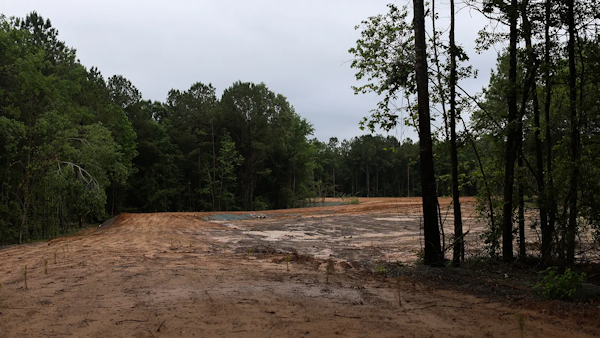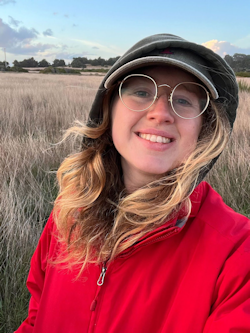SEJournal Online is the digital news magazine of the Society of Environmental Journalists. Learn more about SEJournal Online, including submission, subscription and advertising information.
 |
 |
| The author used a Fund for Environmental Journalism grant to report on possible lithium exploration in old oil fields in the southeastern United States. Above, a churned-up entrance to a lithium test site in Lafayette County, Arkansas. Photo: Lou Murrey. |
FEJ StoryLog: From Oil Boom to Lithium Rush — Reporting the Realities
By Katie Myers
Lithium batteries used in electric vehicles and equipment are considered key to aiding the transition from fossil fuels, so the growing demand for lithium has created a global boom for this critical rare earth mineral.
While the United States has some of the largest lithium reserves in the world, the economic costs of tapping these resources have inhibited production. Only a tiny fraction of these native resources are being produced, leaving U.S. electronic manufacturers to rely largely on imported supplies.
Increased production of electric
cars, trucks and other clean energy
products has renewed interest in
lithium-rich areas like Arkansas.
But the increased production of electric cars, trucks and other clean energy products has renewed interest in lithium-rich areas like Arkansas. I began hearing about lithium exploration in areas previously impacted by fossil fuels, like old strip mines. Then I learned oil fields in southeastern states were becoming part of this conversation.
Lithium boom in former oil community
Long after the wind-down of the oil boom, the Smackover Formation, which stretches across Arkansas, Texas and Louisiana, may supply 19 million tons of lithium, according to the U.S. Geological Survey.
 |
| Journalist Katie Myers. |
After seeing oil company ExxonMobil Corp. investing in lithium drilling rights in southern Arkansas, I began to poke around.
I was interested in the Smackover area not just because it is facing renewed extraction, but because the region is primarily Black, with histories of land dispossession, plantation slavery and Jim Crow segregation, which left the community economically behind its white counterparts.
The goal was to learn the benefits and consequences of the lithium boom for this former oil community.
It seemed like a good story, so I pitched it to Grist while working there as a fellow. It was accepted, in part because I had already developed a contact — a city councilwoman and oil worker’s daughter in the Smackover Formation town of Lewisville, Arkansas — through source chats with people keyed into environmental justice and democracy movements in the South.
I planted the flag with a shorter story on a similar topic. After my contact saw that story, she trusted me more as a repository for stories from her community. We had a number of background conversations, and I made plans to travel to Lewisville to get a clearer picture.
New extraction yields urgent questions
As this new lithium boom revives once-closed extraction areas, I considered what these communities deserve, particularly when causes of poverty are rooted in historical inequities of the past boom, while the resources under their feet could make billions for private industry.
Can this effort unfold in a way that
improves lives rather than merely
changing the face of environmental
damage and economic precarity?
Can this effort unfold in a way that improves lives rather than merely changing the face of environmental damage and economic precarity?
Historic concessions from oil, gas and coal companies involving community benefits and workers’ rights were hard-won through years of struggle. Some unfolded through legal battles, others through bloodier means.
Those benefits included union protections and higher salaries, plus royalties and taxes on extraction to return some of the profits to the landowners and counties whose lands were mined or drilled.
Currently, rare earths industries in Arkansas are still wrangling with benefit options. Royalty amounts remain in a protracted battle. Some locals worry that related jobs might not be made equally available to workers from marginalized backgrounds or with less access to advanced education.
SEJ grant offers reporting latitude
A grant from the Society of Environmental Journalists’ Fund for Environmental Journalism provided a stipend, plus funding for reporting.
Because the grant was funded early in the year rather than on a reimbursement basis, I had some stability and certainty that I would not miss needed income.
Also, it allowed me to get out to a rural area, pay for gas, motel and meals, and gave me a little bit of latitude to make discoveries and go to a few extra places.
With a photographer, I drove through Arkansas to the state’s southwestern corner, seeing how oil extraction had changed the landscape and culture of the area, making time to stop at oil museums and other towns in the Smackover region, and building in some extra days for spontaneity’s sake.
Wading into difficult history, peering into uncertain future
I was walking into histories of hurt and neglect, where the legacies of Jim Crow and deindustrialization have had a tangible impact on living conditions.
Today, many Smackover area towns are economically struggling. In Lewisville, despite the environmental consequences of the oil boom, many are nostalgic for the long-term work and income it provided for the region’s Black families, directly or indirectly.
As national journalists, we are
often strangers in a strange land,
and it is important to approach
that relationship with humility.
As national journalists, we are often strangers in a strange land, and it is important to approach that relationship with humility.
I relied on background chats with local journalists and outlets who were following these issues on a granular level. Though my home state of Tennessee is politically similar to Arkansas, I needed to phone-tree my way through the state to compensate for my lack of knowledge about Arkansas and lack of contacts there.
I also dealt with the racial politics of being an unknown white journalist who sought to speak about sensitive issues with members of a southern Black community, who, if they said the wrong thing, could anger powerful people who held important connections and funding for the future of their communities.
People often were guarded when we first met (as they should be), and I had extended interviews to work through what people were and were not uncomfortable discussing in a more public way.
Like many environmental journalists, I went in looking for straightforward stories of extraction, exploitation and environmental anxiety.
However, as I spoke to people, I found a sense of optimism and determination around the new lithium industry — a sense that communities were willing to organize, bargain and develop relationships with one another and with lithium companies to deliver the best results, in the hope that the immense investment and profits of lithium would leave something left over for them and course-correct previous inequalities.
Mayor Ethan Dunbar of Lewisville had clearly outlined his hopes as he worked with lithium companies and other public officials. He wants funds from lithium proceeds for housing, education and broadband, and pathways to lithium jobs for locals. The work of Lewisville’s leadership is instructive for other communities that are, or will be, facing similar situations.
Katie Myers is a regional Appalachian climate reporter for Grist and Blue Ridge Public Radio. She has worked as a climate solutions fellow at Grist and an economic transition reporter with WMMT 88.7 FM, an eastern Kentucky community radio station run out of Appalshop, an Appalachian arts and culture organization. Her story, “Deja vu comes to Arkansas as lithium follows oil,” was published by Grist on Sept. 25, 2024. Energy News Network followed two days later, publishing “With lithium, Arkansas risks repeating oil boom and bust.”
* From the weekly news magazine SEJournal Online, Vol. 10, No. 7. Content from each new issue of SEJournal Online is available to the public via the SEJournal Online main page. Subscribe to the e-newsletter here. And see past issues of the SEJournal archived here.













 Advertisement
Advertisement 



